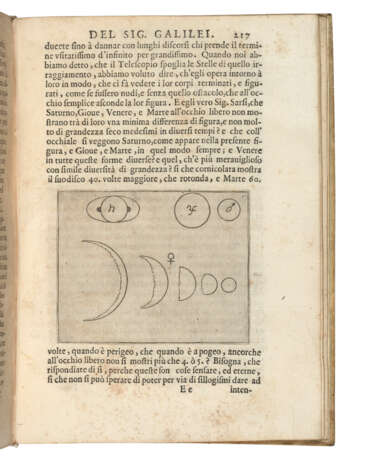ID 794401
Lot 158 | GALILEI, Galileo (1564-1642)
Estimate value
£ 20 000 – 30 000
Il saggiatore. Rome: Giacomo Mascardi, 1623.
First edition, first issue, printed on thicker paper and in a handsome, possibly presentation, binding. In Il Saggiatore Galileo developed the proper scientific basis for an investigation of celestial phenomena. He composed it in refutation of Orazio Grassi's treatise on comets (1618), realising that no theory of comets should be advanced unless it was proved that comets were concrete moving objects and not solar-generated optic effects, a proof he considered impossible. In doing so, he established fundamental axioms for the modern scientific method, specifically distinguishing between physical properties and sensory effects and emphasising the necessity of mathematics in understanding the natural world. Galileo had been forbidden since 1616 to defend Copernican theory but his approach subtly supports the probability of heliocentrism. 'One of the most celebrated polemics in science' (DSB V 243). The engraving on EE1r is the earliest published illustration of the ring of Saturn and the phases of Venus. Three issues of the first edition are known, primarily distinguished by their errata; the present copy has the earliest, shorter errata but has been partly corrected against a longer list of errata in an early hand. DSB V, p. 243; Carli and Favaro 95; Cinti 73; Norman I, 857 (without preliminary leaves); Riccardi I, 511.
Quarto (219 x 158mm). Engraved title, portrait and 18 text diagrams, woodcut initials and ornaments, 16-line errata on final verso, with the preliminary quire a4 (title extended at upper and outer margin and possibly supplied, portrait and dedication rehinged, some browning, spotting and light staining). Contemporary flexible gilt-tooled vellum, missing fore-edge ties, old lettering faded on spine (endleaves renewed). Provenance: text corrected in an early hand – illegible ?18th-century stamp on title – ‘F A’ (modern blindstamp on rear endleaf).
Special notice
No VAT on hammer price or buyer's premium.
| Artist: | Galileo Galilei (1564 - 1642) |
|---|---|
| Place of origin: | Italy, Europe |
| Auction house category: | Printed books |
| Artist: | Galileo Galilei (1564 - 1642) |
|---|---|
| Place of origin: | Italy, Europe |
| Auction house category: | Printed books |
| Address of auction |
CHRISTIE'S 8 King Street, St. James's SW1Y 6QT London United Kingdom | |
|---|---|---|
| Preview |
| |
| Phone | +44 (0)20 7839 9060 | |
| Buyer Premium | see on Website | |
| Conditions of purchase | Conditions of purchase |









![[GALILEO GALILEI (1564-1642) and Girolamo SPINELLI (c.1580-1647)]](/assets/image/picture_4734998/81ecb/b78ba02793ea9f7c89bc2421c803edfc1752012000jpg__fix_162_205.jpeg)



